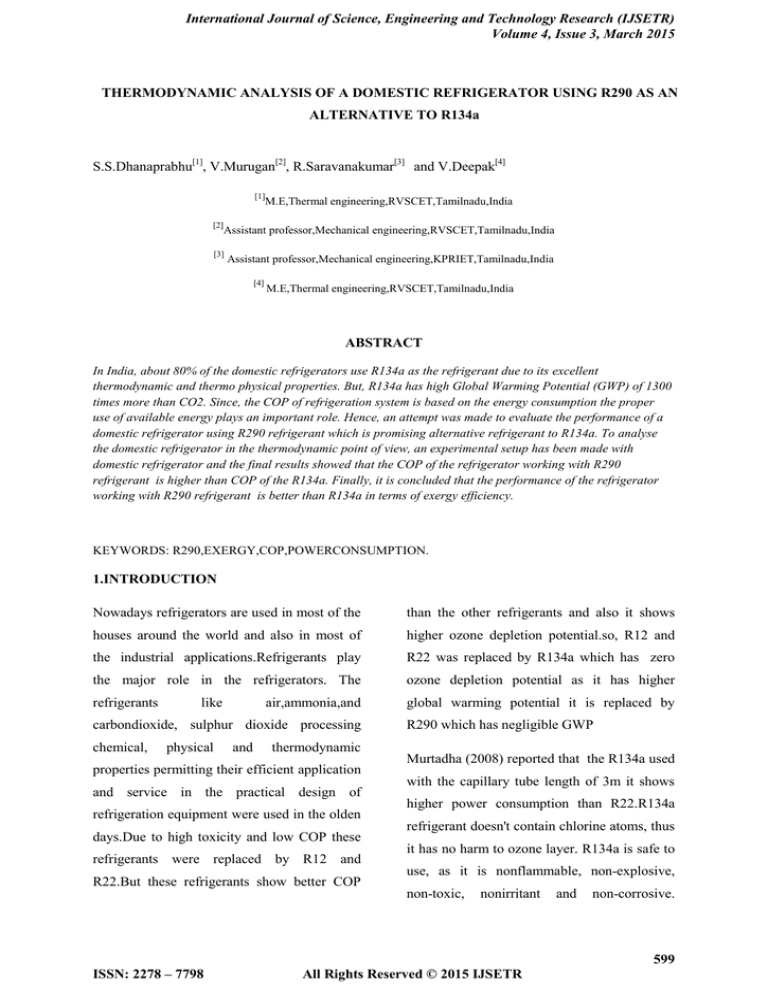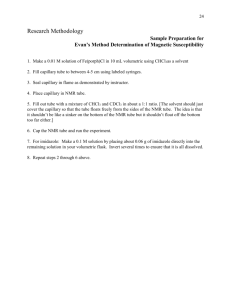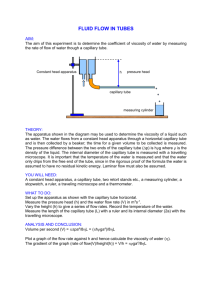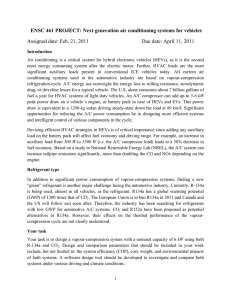
International Journal of Science, Engineering and Technology Research (IJSETR)
Volume 4, Issue 3, March 2015
THERMODYNAMIC ANALYSIS OF A DOMESTIC REFRIGERATOR USING R290 AS AN
ALTERNATIVE TO R134a
S.S.Dhanaprabhu[1], V.Murugan[2], R.Saravanakumar[3] and V.Deepak[4]
[1]
M.E,Thermal engineering,RVSCET,Tamilnadu,India
[2]
Assistant professor,Mechanical engineering,RVSCET,Tamilnadu,India
[3]
Assistant professor,Mechanical engineering,KPRIET,Tamilnadu,India
[4]
M.E,Thermal engineering,RVSCET,Tamilnadu,India
ABSTRACT
In India, about 80% of the domestic refrigerators use R134a as the refrigerant due to its excellent
thermodynamic and thermo physical properties. But, R134a has high Global Warming Potential (GWP) of 1300
times more than CO2. Since, the COP of refrigeration system is based on the energy consumption the proper
use of available energy plays an important role. Hence, an attempt was made to evaluate the performance of a
domestic refrigerator using R290 refrigerant which is promising alternative refrigerant to R134a. To analyse
the domestic refrigerator in the thermodynamic point of view, an experimental setup has been made with
domestic refrigerator and the final results showed that the COP of the refrigerator working with R290
refrigerant is higher than COP of the R134a. Finally, it is concluded that the performance of the refrigerator
working with R290 refrigerant is better than R134a in terms of exergy efficiency.
KEYWORDS: R290,EXERGY,COP,POWERCONSUMPTION.
1.INTRODUCTION
Nowadays refrigerators are used in most of the
than the other refrigerants and also it shows
houses around the world and also in most of
higher ozone depletion potential.so, R12 and
the industrial applications.Refrigerants play
R22 was replaced by R134a which has zero
the major role in the refrigerators. The
ozone depletion potential as it has higher
refrigerants
global warming potential it is replaced by
like
air,ammonia,and
carbondioxide, sulphur dioxide processing
chemical,
physical
and
thermodynamic
properties permitting their efficient application
and service in the practical design of
refrigeration equipment were used in the olden
days.Due to high toxicity and low COP these
refrigerants were replaced by R12 and
R22.But these refrigerants show better COP
R290 which has negligible GWP
Murtadha (2008) reported that the R134a used
with the capillary tube length of 3m it shows
higher power consumption than R22.R134a
refrigerant doesn't contain chlorine atoms, thus
it has no harm to ozone layer. R134a is safe to
use, as it is nonflammable, non-explosive,
non-toxic,
nonirritant
and
non-corrosive.
599
ISSN: 2278 – 7798
All Rights Reserved © 2015 IJSETR
International Journal of Science, Engineering and Technology Research (IJSETR)
Volume 4, Issue 3, March 2015
Compared with R12, R134a has better heat
conductivity.
This
greatly
reduces
consumption
of
refrigerant.
the
BUKOLA.O.BOLAJI(2007) reported that the
ratio of 60:40, by mass fraction) is the most
decrease in evaporator temperature results in
appropriate alternative to R134a due to its
the
the
excellent thermodynamics and environmental
evaporator temperature results in the good
properties. The refrigerator working with
exergetic
performs18.2%
above HC mixture requires less energy
compared
to
conception per day compared to R134a due to
R12.MURTADHA(2008) reported that The
its high latent heat. Fatough and EI kafafy
use of R134a as an alternative refrigerant
(2006) studied the performance of 280 l R134a
along with polyolester oil resulted in a 7.5%
based domestic refrigerator with liquefied
increase in energy consumption compared to
petroleum gas (LPG) composed of R290,
R12.RAHUL UKEY(2012) reported that R12
R600a and R600(60:20:20 by mass fraction) as
has exergy of cooling load higher compared to
an alternative. The results reported that the
R134a.As R12 reports better performance than
pull-down time, pressure ratio and power
R134a
but the ozone depletion potential is
conception of 5m capillary tube length and
high in R12 so R134a which is having zero
charge of 60g was reduced by 7.6%,5.5% and
ozone depletion potential is used as an
4.3% respectively higher COP. Lower on time
alternative for R12.The investigation with HC
ratio and conception of LPG refrigerator by
mixtures composed of R290 and R600 at
nearly
different mass ratio in a 240 l capacity
compared to that of R134a [5].
decrease
reduction
in
COP.Decrease
efficiency.R134a
in
COP
as
in
14.3%
and
10.8%
respectively,
domestic refrigerator by replacing the R134a.It
was reported that R290/R600 mixture (in the
2. EXPERIMENTAL SET UP
A domestic refrigerator was used for
thermometer were connected at suction and
conducting an exergy analysis of R134a with
discharge of the compressor to note down the
the different lengths of the capillary tubes.The
suction and the discharge pressures and the
capillary tube of 0.36mm diameter and lengths
temperatures.Then it was connected to the
of 3, 3.5, 4, 4.5, 5were used to find the COP
condenser and it wasConnected to the drier to
for each capillary tube length.The exergy
filter the dust. It is then sent to the different
efficiency were also calculated to find the
length of the capillary tubes one by one.The
better performance of the refrigerator.The
COP
refrigerant was charge a pressure gauge and a
consumption was noted for different length of
was
calculated
and
the
power
600
ISSN: 2278 – 7798
All Rights Reserved © 2015 IJSETR
International Journal of Science, Engineering and Technology Research (IJSETR)
Volume 4, Issue 3, March 2015
the capillary tubes as per the evaporator
refrigerator experimental setup is shown
temperature
below.
upto
-10°c.same
process
is
repeated for R290 and the performance is
evaluated
and
compared.
The
domestic
Fig1.Schematic diagram of domestic refrigerator experimental setup
COEFFICIENT OF PERFORMANCE
COP=POWER
𝒉𝟐− 𝒉𝟏
CONSUMPTION
EXERGY EFFICIENCY
T
𝜂𝑒 =
R e × (1 − TO
e
WORK DONE
601
ISSN: 2278 – 7798
All Rights Reserved © 2015 IJSETR
International Journal of Science, Engineering and Technology Research (IJSETR)
Volume 4, Issue 3, March 2015
3.RESULTS AND DISCUSSIONS
3.1.POWER CONSUMPTION OF R134a
The power consumption is going to decide the
the refrigerants in all of the domestic
COP of the system. Already the energy
refrigerators.As a result in our project we
resources in India are very limited so we want
found that the power consumption were
to reduce the power consumption in all the
reduced using the capillary tube length of
ways.so In our project we reduce the power
3m.as compared to the capillary tube lengths
consumption in the refrigerator by the
of 3,4,4.5,5.we also obtained
optimisation of the capillary tubes usingR134a
comparable results with the capillary tube
as the refrigerant which is playing the role of
length of 3m.
relatively
2.5
0.03
0.025
2
0.02
1.5
COP
POWER CONSUMPTION
0.035
0.015
0.01
1
0.5
0.005
0
0
3
3.5
4
4.5
5
3
capillary tube
3.5
4
4.5
5
capillary tube
Fig 2.Capillary tube length vs Power consumptionFig 3.Capillary tube length vs COP.
3.2.COEFFECIENT OF PERFORMANCE
In the refrigeration systems the performance is
reduced when the evaporator temperature gets
found only by the COP of the system.It is
less. Considering the evaporator we done the
decided by various factors such as the
experiment with the evaporator temperature
pressure, temperature of the four major
upto -10˚c.we obtained better COP with the
componentslike evaporator,condenser and the
capillary tube length of 3.5m.As the power
capillary tube.when the COP of the system is
consumption is also showed experimentally
high the system is going to be a better
less in the capillary tube length of 3.5m.The
system.The COP of the system is high when
COP also relatively equal to the capillary tube
the evaporator temperature is high and it gets
length of 3m.
602
ISSN: 2278 – 7798
All Rights Reserved © 2015 IJSETR
International Journal of Science, Engineering and Technology Research (IJSETR)
Volume 4, Issue 3, March 2015
3.3.EXERGY EFFICIENCY
The available energy which is used in the
ambient temperatures.when the losses gets
refrigeration system should be better in the
reduced we can obtain the better COP.In our
four
experiment the exergy efficiency tested for the
major
components
evaporator,compressor,condenser,capillary
tube.The
losses
may
be
due
different capillary tube lengths, respectively
to
40
35
30
25
20
15
10
5
0
obtained the exergy efficiency of 37.7%.
0.04
POWER CONSUMPTION
EXERGY EFFICIENCY
frictionevaporator design,and due to the
with the ambient temperature of 32˚c.we
3
3.5
4
4.5
0.03
0.02
0.01
0
3
5
CAPILLARY TUBE LENGTHS
3.5
4
4.5
5
CAPILLARY TUBE LENGTHS
Fig 4.Capillary tube length vs Exergy efficiency. Fig 5.Capillary tube length vs Power consumption
3.4.POWER CONSUMPTION OF R290
As the power consumption in R134a has
lengthsThe power consumption is highly
higher global warming potential it is replaced
reduced in capillary tube length of 4.5m and it
with R290 . The power consumption was
got increased in the capillary tube length of
noted
size of 3 m.
with the
different
capillary tube
3.5.COEFFECIENT OF PERFORMANCE
As the power consumption reduces there will
R134a.It is also shows that the R290 is an eco-
be a change in COP.It is observed that the
friendly refrigerant and can be used in
COP is better in the capillary tube length of
domestic refrigerator without any change in
4.5 . COP also increased as compared to
compressor in a domestic refrigerator.
603
ISSN: 2278 – 7798
All Rights Reserved © 2015 IJSETR
International Journal of Science, Engineering and Technology Research (IJSETR)
Volume 4, Issue 3, March 2015
50
EXERGY EFFICIENCY
5
COP
4
3
2
1
0
3
3.5
4
4.5
5
CAPILLARY TUBE LENGTHS
40
30
20
10
0
3
3.5
4
4.5
5
CAPILLARY TUBE LENGTHS
Fig 6.Capillary tube length vs COP.Fig 7.Capillary tube length vs Exergy efficiency.
3.6. EXERGY EFFICIENCY
Exergy efficiency gives the pressure and
friction losses and bent losses and refrigerant
temperature losses in each capillary tube
R290 takes lesser amount of refrigerant than
lengths.it was better in capillary tube length of
R134a.It also gives better exergy efficiency
4.5m for R290. The losses are mainly due to
than R134a.
4. CONCLUSION
The COP and the exergy analysis were done with the optimization of the capillary tubes .The power
consumption is mostly reduced for the capillary tube length of 3.5m for R134a.The capillary tube
length of 3m shows nearer reduced power consumption compared to3.5m.The exergy analysis also
showed that the capillary tube length of 3.5m shows better exergy efficiency .The COP is obtained
better in the 3.5m.The power consumption is reducedso the capillary tube length of 3.5 is better
preferable for the domestic refrigerators using R134a as refrigerants.As the R134a has higher global
warming potential it should be replaced with a eco-friendly refrigerant. It is replaced with R290 which
shows less power consumption at the capillary tube length of 4.5m.It also needs lesser amount of
refrigerant .R290 also gives better COP and exergy efficiency at the capillary tube length of 4.5m.so it
was concluded that the R134a can be replaced with R290 in the domestic refrigerator.
604
ISSN: 2278 – 7798
All Rights Reserved © 2015 IJSETR
International Journal of Science, Engineering and Technology Research (IJSETR)
Volume 4, Issue 3, March 2015
REFERENCES
1.
Rahulukey, Sharadchaudhary (2012) Exergy analysis of domestic refrigerator with different
refrigerants.
2.
BUKOLA O. BOLAJI (2007) Exergy analysis of domestic refrigerator using R12 and its
alternative refrigerants.
3.
Dr.TalibKshashMurtadha (2008) Domestic refrigerator energy testing with alternative
refrigerants.
4.
J.K.Dabas,Performance characteristics of vapour compression refrigeration system under real
transient conditions.
5.
A. Baskaran, Comparative study of environment friendly alternatives to R12 and R134a in
domestic refrigerators.
605
ISSN: 2278 – 7798
All Rights Reserved © 2015 IJSETR








